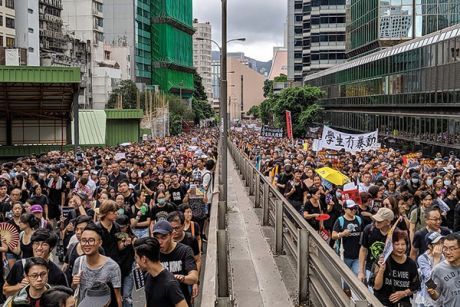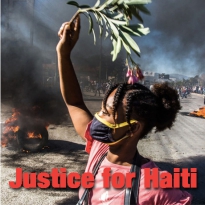News
You are here
‘The movement is at a critical point’—voice from Hong Kong

August 8, 2019
After nearly two months of protests,Hong Kong’s mass movementhas reached a critical moment.
The movement has been preparing for strikes that began this Monday.
Some 96 trade unions, under the Hong Kong Confederation of Trade Unions, announced their support for the strike. And workers at Hong Kong Airlines and Cathay Pacific, social workers, university teachers, and Radio Television Hong Kong employees said they would walk out.
The attempt at this political strike is significant—as there hasn’t been one since the strike wave against British colonial rule in 1967. And it comes at a time when cracks are appearing within the ruling class.
The Liberal Party, a big business party that supports the Chinese regime, has been forced to call for the resignation of Hong Kong chief executive Carrie Lam. The chief executive is appointed by the China, which rules it as a “special administrative region”.
The Liberals have also come out in favour of an independent investigation into police violence at the end of June. This is echoed by bosses’ organizations, the Hong Kong General Chamber of Commerce and the International Chamber of Commerce.
This is the result of pressure from below.
A rally, called by rank-and-file civil servants, saw 40,000 people take to the streets on 2 August.
At the same time Carrie Lam still refuses to fully withdraw the suspended Extradition Bill. The draconian law, which sparked off the protests in June, would make it easier for the Chinese regime to extradite people.
Yet, while clear differences are emerging within the government, they have not reached the point of the open split.
The movement has spread to all districts in Hong Kong. Since July rallies, demonstrations and roadblocks have taken place in Tsim Sha Tsui, Sheung Shui, Tuen Mun, Sha Tin, Yuen Long, Tseung Kwan O and Sheung Wan.
The number of participants ranges from tens of thousands to more than 200,000 people.
The demonstrators put forward five major demands, firstly for the government to completely withdraw the extradition bill. They want the police to stop saying the June 12 protests were “riots”, the unconditional release of all arrested protesters, and an independent inquiry into the cops’ behavior.
And protesters are pushing for greater democratic rights, with a demand for universal suffrage and the democratic election of the territory’s leaders.
The Hong Kong government hopes to discredit the demonstrators as a riotous mob. By doing this, it hopes to regain some popularity from the masses which is now at an all-time low.
But, despite its best efforts, public opinion has not been significantly reversed. On the contrary, the police’s obvious collusion with organised crime aroused greater anger among ordinary people.
One such incident took place in Yuen Long, a town in the New Territories district, on the evening of June 21.
Around 300 people, with backgrounds in the Triad criminal gangs, entered the subway station and indiscriminately attacked the demonstrators and the general public. The police deliberately held back, allowing a large number of people to suffer injuries.
On the same night politician Kwan-yiu Junius Ho was filmed supporting the gangsters. He told a mob of them, “All of you are my heroes”, and gave a thumbs-up gesture.
The Triad gangs are directly controlled by the landlords in the New Territories, who were a privileged layer under British colonial rule.
Regime
Since Hong Kong was returned to China in 1997, the Chinese regime has used them for its own ends. It claims they are the backbone of “patriotic and Hong Kong-loving” forces on the ground.
This sort of state-sponsored violence hasn’t deterred protesters. Six days after Yuen Long attack, more than 200,000 people took to the streets in defiance of a police ban.Demonstrators have set up self-defense pickets to protect themselves from further attacks by the mob.
And some demonstrators have realized that they need to unite with the masses on the Chinese mainland. They distribute leaflets to tourists from mainland China to explain the purpose and significance of the mass movement.
However, there are also weaknesses in the mass movement.
Demonstrators are easily tempted by police to attack sensitive buildings, incurring greater repression.
There is also a far right threat.
Individual demonstrators sprayed “Chink” outside the Liaison Office government building.
Since mid-July, the slogan “Liberate Hong Kong—revolution of our times” became popular among the demonstrators. The slogan was derived from the far right political group Hong Kong Indigenous.
The group’s use of the slogan heavily implies a form of “ethnic discrimination” against mainland Chinese residents and new immigrants from China. But, at present, it is unclear how the majority of young people who embrace this slogan interpret its meaning.
Meanwhile, the Chinese Communist Party (CCP) regime is backing Carrie Lam and the police force to the hilt. They want the Hong Kong government to begin rejecting some applications for protests, and to strengthen the police’s repression of the most radical protesters.
Unless the Hong Kong police can no longer control the situation by itself, the regime is unlikely to dispatch the army.
This raises questions about how to take the movement forward.
The socialist left in Hong Kong, which isn’t aligned with the CCP regime, fully supports political strikes. And it calls for social and economic demands to be included as a part of the strikers’ demands.
The strike on Monday is only an initial attempt, and a larger and longer general strike will be launched in the future.
At the same time protesters, trade unions, student unions and social movements must combine into a joint action committee to lead the struggle. Through the action committee, the power of the workers and movements will converge. And this would establish the mass self-organization that can take on the power of the ruling class.
Section:










